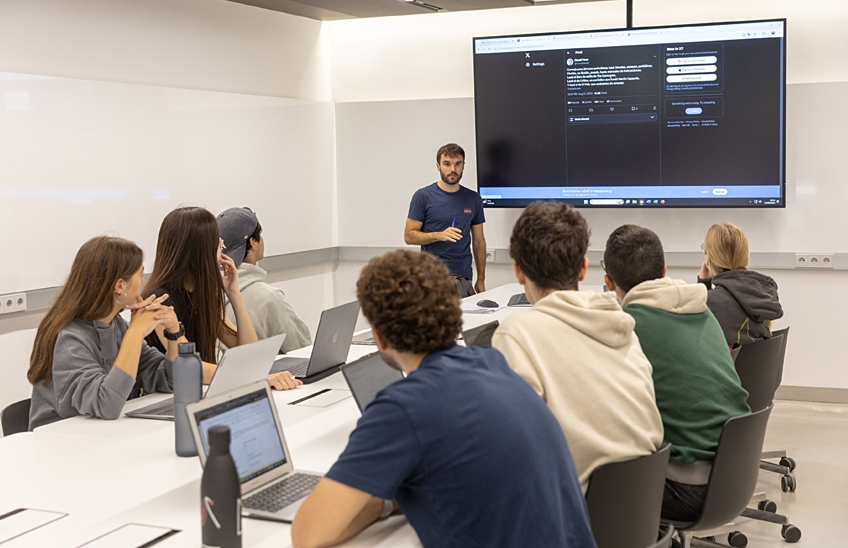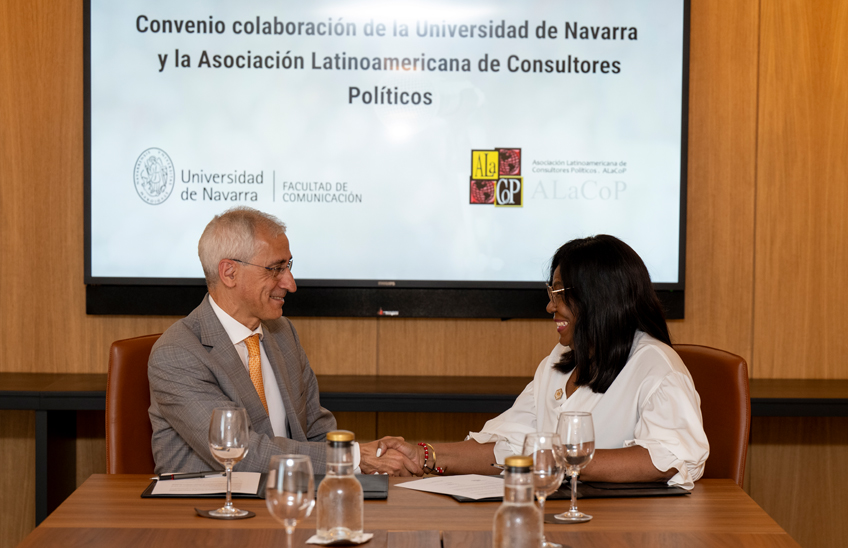The assassination of Miguel Angel Blanco and its impact on children and adolescents
The University has digitized and analyzed more than 300 letters written by children of all ages to preserve the collective report and reinforce the commitment to freedom.

PhotoManuelCastells/From left to right: Inés Irurita, deputy director of the General file of the University of Navarra; Cristina Cuesta, director of the Miguel Ángel Blanco Foundation; and María Jiménez, professor at the School of Communication and director of the project.
21 | 11 | 2025
The School of Communication of the University of Navarra has presented the new website that collects and disseminates the letters, drawings and messages that hundreds of children and teenagers sent to the family of Miguel Angel Blanco during his kidnapping and after his assassination in July 1997. The project is part of the conservation and analysis work of the Miguel Ángel Blanco Fund, donated in 2022 by the family and guarded by the General file of the University of Navarra.
In total, the collection includes more than 3,000 documents, of which 293 were written by children under the age of 18. These materials, from all over Spain, reflect the profound emotional and social impact that the murder of the Ermua councilman had on the younger generations.
The website, open to the public, allows you to consult the nearly 300 original letters and drawings, digitized and contextualized by the research group Narrative, Violence and report of the School of Communication. The team has analyzed the public response, the language employee, the emotions of the authors and the role of children and adolescents in the civic awakening that followed the crime.
María Jiménez, principal investigator of the project, pointed out that "the kidnapping and murder of Miguel Ángel Blanco is one of the few events that underpin our collective report : those who lived through it remember what they were doing or where they were when it happened. The letters from children and teenagers show that the impact reached all citizens and that a whole generation knew what ETA and terrorism were and the importance of civic participation after Miguel Ángel".
Cristina Cuesta, director of the Miguel Ángel Blanco Foundation, said: "Today is an important day for the preservation of Miguel Ángel Blanco's report and its social significance. Miguel Ángel Blanco is a symbol of coexistence, a reference for the thousands of victims that terrorism has caused in Spain. Each letter, and especially the letters of the children who wrote to the Blanco Garrido family, are historical documents of the best that we did together in the fight against ETA. In each letter, in each drawing, is integrated the emotional connection that Miguel Ángel awakened among the citizens, his innocence and his truth".
Inés Irurita, deputy director of the General file of the University of Navarra, also participated in the presentation , who valued "the relevance of primary sources in the dissemination of history and the responsibility of preserving and guarding this file for the future".
A file to understand a historical turning point
According to the first conclusions of the study, the viewpoint of minors provides a core topic dimension that has been little explored in research on terrorism in Spain. In the letters it is observed:
-
Massive grief and solidarity, with messages of support showing that the Blanco family was not alone.
-
Unanimous rejection of ETA, with resounding expressions of indignation and demand for justice.
-
Unprecedented social mobilization, with more than 70 minors claiming to have participated in demonstrations for the first time.
-
Deep empathy and shared grief, especially for the councilman's mother and siblings.
-
Commitment to a peaceful future, with messages that appeal to coexistence, freedom and hope.
-
Recognition of the historical impact, considering Miguel Ángel Blanco a civic symbol that marked a generation.
The letters come from more than 40 provinces, with Madrid and Barcelona being the most represented territories.
An educational tool
The digitization and dissemination of this material aims to enable those who wrote these letters to update the commitment they made 25 years ago and for new generations to reflect on the impact of terrorism. The file aims to become a pedagogical resource for primary and secondary school teachers, facilitating the teaching of the history of terrorism and democratic values. To this end, the website includes a didactic guide for teachers, as well as a mailbox for them to share their experiences.
The project, developed on the web by the business Creartelia, has the partnership the Miguel Angel Blanco Foundation and the Victims of Terrorism Foundation.
Access to the website: unav.edu/fondo-MAB



